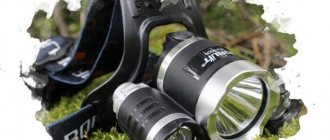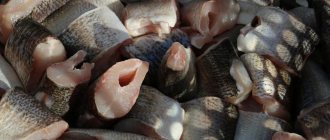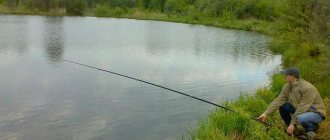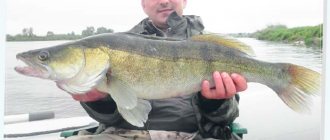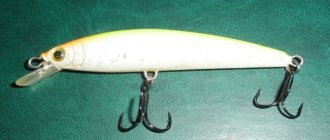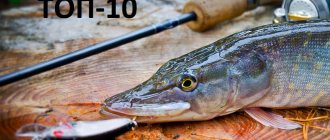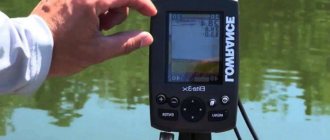Night fishing, catching fish with a net
Beaming fish, in my opinion, is the most exciting way of fishing, fishing takes place at night, this already adds romanticism and mystery...
I’ll say right away that in this type of fishing I used not a spear, but a net.
This type of fishing is prohibited by the Fishing Rules as poaching, but I would like to argue, since a net does not injure the fish.
If, in the case of fishing with a spear, a lot of fish are damaged and simply die in the future, then it will not be possible to injure the fish with a net and it will leave unharmed.
I don’t know a more exciting and exciting way to catch fish
Yes, about the excitement - think for yourself, you’re walking along the river and in the beam of a flashlight you see a fish standing, the hunt has begun...
Every time everything happens differently, different fish, different sizes, different bottom topography, which is very important, since the net is pressed to the bottom, depth, the soil at the bottom is of great importance, and a lot of other nuances.
You have to learn this method; rarely does anyone succeed the first time, but after several nights spent on the river, mastery will come on its own and you won’t be left without fish.
And what a delight, buzz or something else you feel, words cannot describe when you feel the weight in the net and how the prey is beating.
They showed me this method of fishing in 1992, I was fishing on mountain taiga rivers in the north of the Republic of Buryatia, BAM zone.
Most often I wandered along the Muya River, where there are large sand spits - an ideal place for casting a net. Usually I caught grayling and valka (whitefish), as well as small-sized fish (like capelin) tugun (also a whitefish).
Sometimes, taimen and lenka were found, but less often. In the early 90s, there were a lot of fish there, as well as rayfish; on Saturday night, sections of the river shone with the lights of lanterns like New Year trees.
Perhaps the general decline in the standard of living of many families in those hard years also had an effect, so they tried to survive on fish. In short, on the banks of the river there were people like on city streets, they walked along the spits one after another and, strangely, there was enough fish for everyone, no one was left without a catch.
In the last 5-6 years, the fish have left those places almost completely; we began to notice that there were fewer fish in the early 2000s. Most likely, this is due to climate changes in those places.
Winters have become warm, frosts over 40°C are rare. If in the 90s, under a rubberized suit or boots, “swampers” wore “quilted jackets” and woolen socks, otherwise their feet would get cold, but in recent years, you walk along the river at night in a T-shirt and it can even be hot, and the water is warm like milk, and that’s in the end August, early September.
How does the fishing process work?
Let's end this sad digression and move on directly to the process of beaming fish and equipping the fisherman.
You go out onto the river looking like this:
- in a waterproof suit (fisherman's suit or OVZK) or high boots (you can't go deep in boots)
- in one hand - a flashlight (preferably on a belt)
- in the other - a net
- a bag or box for catch on a shoulder strap, hanging slightly below the waist.
At that time we used miner's flashlights; they shined beautifully, of course, if they were well charged. With the advent of Chinese consumer goods, they began to switch to brighter flashlights, which held a charge longer and weighed less.
The main thing is that the beam penetrates the water a meter and a half deep; it is no longer required, since you still won’t be able to go that deep. And in terms of distance, the farther it shines, the better, you walk 20 meters from the shore up the river and see everything 180 degrees. As a rule, there are small fish near the shore, but there may also be a good burbot or grayling, and a roller or a timefish is standing on the current and deeper.
The fish is clearly visible, if you illuminate it from the side, you immediately need to move the beam to the side, but so that the object of the hunt is visible and does not scare the fish away with the light (keep it in the shade). Next, you try to quietly approach the fish from the tail, without making any disturbance on the surface, since you can lose sight of it if the fish moves or simply scare it away.
That's it, the net is above the fish, but does not touch it, we make a sharp movement with the net forward and down, covering the prey.
Usually, the fish, trying to free itself, begins to rush under the net and, rising, gets stuck in the narrow conical part of the net - in other words, “motne”, at this moment, you sharply pull the jump out of the water, take out the fish and put it in the bag that you carry with you over your shoulder.
It happens like this - the fish did not react to the fact that it was covered with a net and stands quietly, this very often happens with burbot, lies like a cat and slightly moves its tail.
We try, without lifting the net from the bottom, to move it, this is most often enough for the prey to start rushing about, but there have been cases when we had to kick it with a boot.
It’s very inconvenient to fish from a boat with a net, and it’s difficult to row against the current, so you go into the river in a waterproof suit and wade up, usually we walked 3-4 kilometers during the night, if there were few fish, we moved to other places where there were long streams .
This kind of fishing is very dependent on the weather, that is, if the wind blows, then there are ripples on the water, and therefore nothing can be seen, the same thing in the rain.
Now it's time to tell you how to make a net
Making a net
To make a net you will need:
- mesh with a mesh of 10 x 10 mm (5 x 5 mm is also possible) canvas size is approximately 1200 x 1200 mm (very good if you have a ready-made connected net or some kind of mesh blank)
- steel, springy wire with a diameter of 3 ÷ 4 mm, a meter and a half long.
- steel pipe with a diameter of 25 ÷ 30 mm and a length of 25 ÷ 30 cm
Fishing with a red lantern
We all love funny stories about fishing and fishermen, but this incident, although very old, is real and our company doesn’t really like to talk about it, it’s a little embarrassing to remember.
And everything happened like this. We gathered in a small group of five for fishing. We settled down on the shore of a very beautiful lake, as usual, set up a camp table, of course, drank a little, how could we do without it, and began to prepare our gear. And then, like in a fairy tale, out of nowhere, a grandfather appeared in an old, worn-out military jacket, and instead of a leg he had a prosthetic. The old man's chest was decorated with order bars, and he had a cap on his head.
Smiling, the grandfather said: “Have you come to fish? It's late, sons, it's late! There are no fish in this lake anymore - last year poachers killed them all with electric fishing rods. You’ll just work in vain, you’ll…” What can I say, our mood, of course, plummeted. We invited grandfather to sit with us, eat and drink. At first he resisted, he kept talking about his poor health, but then he gave in. He sat down at our makeshift table, drank one glass, another, a third... From his appearance we understood that grandfather wanted to tell us something, but could not decide.
But finally, the old man decided: Sons, I see that you are good people, so I decided to tell you a secret. But swear not to tell anyone about him. Otherwise, if my fellow countrymen find out, I’ll be in trouble. Of course, there are no fish here, but there is something even better - crayfish of this size! – Grandfather spread his arms more than half a meter. If you know the secret of catching them, you can catch five bags in a night. And the secret is simple. Then grandfather began to tell us in detail in a low voice.
The gear offered by my grandfather included an old large boiler, a board and a red lantern. The old evaporation must be installed on the shore, next to the water, and one end of the board should be directed into the water, and the other should be placed on the edge of this evaporation. The lantern had to be placed a little behind the boiling water, so that the light of the red lantern was directed towards the lake. “You will take the waste from an old trash can, break a board from my personal fence, and install a flashlight and battery from your car,” the grandfather advised. At night, the crayfish, attracted by the light of the lantern, will begin to crawl along the board and then fall into your boiling water.
Just remember, under no circumstances should you joke or laugh. As soon as the boil is full of crayfish, you take them out and put them in bags moistened with water, and then in the grass, where they will be alive and fresh for a long time. Although I see that you don’t even have bags. But that's not a problem, I'll sell you mine. “Grandfather, maybe we should try fishing and throw in our gear?” we asked. Over there on the other side of the lake, some fishermen are already apparently fishing. “Then the fools are sitting there, they don’t even realize that there are no fish here. And if you throw away the gear, the crayfish will get scared, crawl into holes and not come out, and you will be completely left without a catch,” the grandfather muttered angrily.
Field test. Fenix HP40F is a flashlight for fishing.
A large pond near the village of Lipitino, Ozersky district, Moscow region, was chosen as a place for recreation and fishing. We arrived there in the evening, set up camp, whipped up some sandwiches and threw our gear into the water. Even I was tempted by this idea. They gave me some gear (I had some kind of fishing rod with a reel), told me it was a “crucian carp killer,” and quickly taught me the fishing method. It turned out that everything is simple - you need to stuff the bait into spiral feeders, hang the dough on the hooks and throw it as far as possible; The main thing is not to get mixed up with other people’s fishing lines and not to catch anyone when casting. Then you put the rod on the stand, hang the bell and wait.
When it got dark, I collected the lanterns and distributed them to the fishermen. The initial version that blue light does not scare fish was doubtful for everyone. Moreover, when approaching the shore, the fish are frightened not so much by the light as by the vibration created by our feet when walking along the shore or bridge. But even if we accept the fact that the blue spectrum is invisible to fish, the question remains: why is this necessary when fishing, for example, with donk?
The truth was revealed suddenly and clearly. Most fishing gear is painted in “acid” colors. Green bell pegs, red bobber heads, orange rod ends all glowed brightly in the blue beam of the headlamp. It's like shining a powerful UV flashlight. The floats were visible at a distance of up to 50 meters. In the dark, it was enough to turn on the flashlight from one place, sitting in a chair, and it immediately became clear which bell was ringing and twitching. You can, of course, equip floats and clothespins with chemical light sources or use illuminated floats, but this will not help you in any way to remove the caught fish or attach the bait, not to mention the ability to safely reach the fishing rod at the moment of the bite. The HP40F makes it easy to alternate white light with blue light at the right time. Although, if you are prepared for everything around you to turn a strange color, you can use just the blue eye all night long. For example, that’s what we did.
I don’t know whether it was thanks to the lanterns, or whether the bait was so secret, but all night and morning we had more ringing than the average along the shore. With a short break for sleep, by the middle of the next day we had already caught a full tank of crucian carp and several perches. By the way, the lanterns performed very well even in the morning fog that densely enveloped the lake and surrounding fields.
There was still an hour and a half left before sunrise; it was cool and damp. No one wanted to leave the fire, so it was necessary to determine whose bell was ringing (and there were 9 of them) with the help of a flashlight, which with its beam made the curved ends of the fishing rods and the clothespins of the bells glow.
When the sun rose, the fog cleared, and the need for flashlights disappeared, I finished off the remaining charge in the batteries by charging the phone from them. The battery pack has a USB connector for this purpose. However, this turned out to be difficult. I, like most people, don't read instructions, especially for flashlights with two buttons. And at first the phone did not want to charge.
After changing different cords and phones, I decided to examine the battery pack more thoroughly. There was a button on it to check the remaining charge. When pressed, it showed 2 divisions out of 4. It was then that I remembered that Phoenixes, like most modern devices, have two functions on one button, and in order to find the second function, the button must be held down. I pressed the button and there it was, the smartphone screen came to life and showed the charging process. At this time, the charge indicators on the battery pack lit up alternately. I wonder if the lantern will light? Checked it - it's on. This means that the process of fishing and charging the battery can be combined. This will be very useful for those who are going to fish on a boat.
I was convinced of this on the same day. A fisherman swam out right in front of us, and most of the time, instead of fishing, he was talking on the phone. He said how much his comrade on the other boat had caught, how much we had caught, how good the bite was for everyone here. As a result, he swam to the shore with three perches in the cage. In any case, the ability to increase the operating time of a mobile phone or GPS navigator is a necessary feature.
Based on the test results, the friends made the following decision.
- The blue color really helps when fishing. Even if there are HISs hanging on the bells and floats, they are visible many times better in the blue beam, even at minimum brightness.
- The operating time is suitable; without recharging the mobile phone, one pair of batteries would be more than enough for the whole weekend.
- The battery pack needs to be modified. Not everyone found the fastening convenient; it got in the way when squatting to remove fish or set bait. Although when using, for example, a belt bag, there will be no such problem.
- The ratchet of the flashlight is a bit harsh, you have to apply force to it to change the angle of the flashlight. We agreed that it would work out over time.
- Most initially had difficulty remembering which button turned on which light. But everyone noted the fact that the buttons themselves work correctly. The flashlight is turned on with one short press: this is important when you need to quickly find out which donkey is ringing.
- We unanimously agreed on the usefulness of the USB connector. There is no need to buy and carry a separate power bank with you.
In general, now I know what to give my fishing friends for the holidays. I myself also realized the importance of a headlamp, especially after several attempts to use only my handheld one. It is much more convenient to remove fluttering fish, attach bait or throw a donk into the water with two hands.
Text and photo: Stepan Fedorov
Raying fish
From the editor:
Attention! The described method of catching fish is illegal and prohibited by fishing rules:
Excerpt from the Fishing Rules of the Tver Region (dated 10/21/03 with amendments dated 06/07/2005): 3.10. Prohibited: 3.10.6. Fishing using explosives and toxic substances, electric current, piercing fishing gear (spear, harpoon, spear, etc.), firearms and pneumatic weapons (except for weapons for underwater hunting), as well as using the method of bagging, jamming, beaming, bogging , rattling and other fishing methods not provided for in paragraph 3.1 of these rules.
Excerpt from the Rules for Amateur Fishing in Water Bodies of the Moscow Region (dated March 16, 2011): Article 8. Prohibited: 8.5. Fishing with the use of explosives and toxic substances, electric current, piercing fishing gear, firearms and pneumatic weapons (except for weapons for underwater hunting), as well as the method of purging and jamming; loops, net tools and traps of all types, with the exception of the hoist (scraper); construction of fishing poles and other types of barriers; drainage of reservoirs for the purpose of fishing; installation of lines and other hook fishing gear with more than 10 hooks. 8.6. Underwater hunting during the spawning period in places of mass and organized recreation for citizens (beaches, recreation areas, areas of health institutions, etc.), as well as the use of underwater hunting from the shore, from the side of watercraft and wading; hunting using scuba gear and other self-contained breathing apparatus.
I want to describe a fishing method that I think is far from secret, although many may not know it. The method is quite barbaric, although personally I think it’s better and more fun than networks.
So, everything you need to catch fish: A boat, a battery (from a car), a headlight on a stick (low beam), a spear or a speargun (in my case, a shotgun)
Mandatory condition: absence of wind or rain, or rain in the case of an existing leeward shore, relatively clear water, visibility - at least 80 centimes. The reservoir should have sloping, shallow banks.
We put all the ammunition in the boat, and go ahead, fill the headlight with water (this way the headlight shines better under water), charge the underwater gun, connect to the battery, turn it on - and here it is - the whole underwater world at a glance. One rows (very slowly), the second has a headlight in one hand, a gun in the other, it is better to go at a depth of 30 to 80 cm, inspecting the entire space.
If you see a fish, you give the command “stop” to the oar, smoothly move the gun to the closest possible distance from the fish, take aim and shoot. At a depth of up to 50cm, the probability of a hit is 80%, the deeper, the less. In any case, you need to train your hand. There were cases at the Tverskoy quarry when they killed a pike of 0.5 kilos from 2.5 meters (the water there is very clean, visibility at night with a headlight is about 6 meters, when we swam for the first time, there was a shock: we swam out, turned on the headlight, it felt like you were on a boat on You are floating in the air, you are sitting in a boat, and there is a vacuum under you.
Choosing a flashlight for spear fishing
Light characteristics are the main indicator of the quality of a flashlight purchased for fishing on the stockade. And here it is better to opt for an LED device with a soft, close-to-yellow tint of the light beam. Such light is practically not reflected from the bottom, as well as from organic particles in the water, allowing you to examine the illuminated objects in as much detail as possible. As for cold white light, it is not desirable for two reasons: firstly, almost all types of fish are afraid of it, and secondly, it is reflected from the water surface and greatly blinds the user.
You can also use flashlights with a red LED for spear fishing. This light is not visible to fish, which significantly increases the chances of success. However, it is worth considering that red light will be appropriate only at a depth of up to half a meter and only if the water is clear. Red light passes through muddy waters much worse than soft light.
As for focusing the light beam emitted by the flashlight, it is better to opt for narrow, concentrated light with minimal side illumination. This will allow you to focus your gaze on a small area of the water surface, and will also not distract the fisherman with glare from the water.
Headlamps for fishing
Headlamps have long become an indispensable attribute for people leading an active lifestyle. They are needed by hunters, tourists, climbers, speleologists, cyclists and, of course, fishermen. However, there are subtleties and nuances here. The fact is that some light can repel certain types of fish, but some, on the contrary, are attracted by the light. First of all, these are large and predatory species. However, we should not forget that catching a lantern is considered poaching. Of course, the flashlight must be powerful enough for this.
Choosing a flashlight for spear fishing
Light characteristics are the main indicator of the quality of a flashlight purchased for fishing on the stockade. And here it is better to opt for an LED device with a soft, close-to-yellow tint of the light beam. Such light is practically not reflected from the bottom, as well as from organic particles in the water, allowing you to examine the illuminated objects in as much detail as possible. As for cold white light, it is not desirable for two reasons: firstly, almost all types of fish are afraid of it, and secondly, it is reflected from the water surface and greatly blinds the user.
Requires filters
No manufacturer makes flashlights specifically for fishermen, so you have to choose based on your experience and vision of the situation. It is best to choose from models that allow you to use light filters. The opinions of experienced fishermen may vary, but they usually agree that fish pay the least attention to blue light. This does not mean the white-blue that diode lamps create, but the blue from the filter. However, it can cause slight discomfort to the fisherman himself, unlike the red light. Red also does not bother the fish much, nor does green. But the latter makes objects more contrasty and can also cause fatigue for the fisherman.
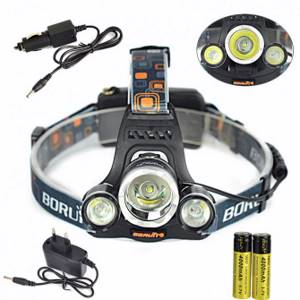
So, the worst thing to do when fishing is to use regular white light and white-blue light. Red is best for the fisherman, but blue is the least likely to frighten fish, although the fisherman can quickly get bored.
Which models are right for us?
Choosing a good flashlight is quite easy. For example, fenix headlamps have proven themselves well among fishermen. You can find something for yourself on the website https://fenix-ua.com
Below is another overview of worthy models:
HL K-9
An example of a suitable model is the Hangliang HL K-9. The brightness of up to 180 lm is created by the American-made CREE Q3-WC LED. There are three operating modes - bright, economical and signal, which turns the flashlight into a flashing beacon. The range at maximum focus is up to 170 meters, which is quite enough for any purpose. The headlight angle is more than 90 degrees. The case is waterproof. In general, you should not chase the ability of a flashlight to work underwater. For our purposes, it is enough that it does not break if it accidentally falls into the water. The flashlight is battery powered and is intended for use in the forest. Practice has shown that when combining bright light and economical light, it worked from 11 pm until early morning. Charges from 220 V. Three filters - red, blue and green.
FA-686-2
Another option, a little more expensive. If HL K-9 can be bought for 1 thousand rubles, then FA-686-2 for about 1300. One more filter - yellow is also added. This model is completely universal - can be mounted on your head or on the handlebars of a bicycle. Power is supplied by an 18650 battery. Its capacity is 4200 mAh, and the operating voltage is 3.7 V. Brightness is 180 lm. The same CREE Q3-WC LED is used.
General information
The choice of such devices has certain reasons. The lamp is a universal assistant not only for the fisherman, but for any traveler or tourism fan who finds himself far from civilization. It is compact and easy to use. It can be mounted under the ceiling of the tent, near the gear on the shore, or on the bow of the boat.
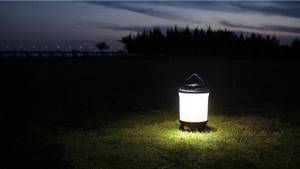
Typically, lamps have a special attachment on top.
However, such a device still remains a stationary light source, and the fisherman often needs something else that has higher mobility. The solution to this problem is to use a headlamp, since it is not only a portable light source, but also has a very important advantage - it keeps the fisherman’s hands free.
The development of modern electronics can significantly expand the capabilities of such devices. The use of LEDs in flashlights instead of incandescent lamps significantly extends their operating time without recharging batteries or replacing batteries.
But efficiency is not the most important advantage of such sources. To date, many LEDs have been developed in a variety of colors and radiation intensities. In addition, the beam from a flashlight can be either focused or diffuse.
Most of this kind of lighting fixtures have the same type of design. Its basis is a belt made of elastic fabric. It covers the head at approximately forehead level. To prevent this belt from sliding down and getting into the fisherman’s eyes, another tape is used, located perpendicularly, attached to the main one on the forehead and back of the head. At these same points, the light source and battery compartment are attached to the entire structure, respectively.
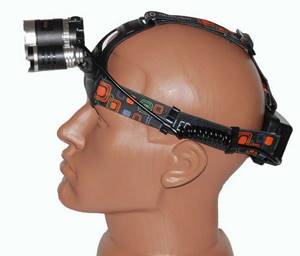
Mounting a headlamp for fishing on the head.
Thus, the entire structure is an improvised headdress with a flashlight over the forehead and batteries (or batteries) at the back of the head. All belts can be adjusted in length using plastic fasteners. This means that the lantern will not only fit the owners of both large and small heads, but can also be worn over a hat in the cold season.
What parameters did we focus on?
So where did we start? Having several headlights is good, but for fishing one is enough, but with the ability to use filters and change the angle of inclination. It is difficult to say for sure what the advertising claims that a certain lamp shines for a kilometer hide behind. 150-200 meters is quite enough. The device must be powered by a battery and not by batteries. Just for cost reasons. It is better to take those models that are intended for both hunting and fishing. And of course, you need a reliable and waterproof case. However, this should not be taken to the point of absurdity. You can also buy a flashlight for diving or spearfishing, but it will cost much more.
